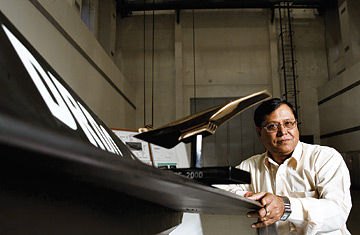
Dr. V. K. Saraswat, the head of research and development at the Defense Research and Developmental Organization.
If Vijay Kumar Saraswat has his way, we will soon be adding spaceflight to the list of industries in which India uses its tech savvy and low costs to get ahead. Saraswat, 58, is the head of research and development at Indias Defense Research & Development Organization, a government body that has spent more than a decade working to build a machine that no space-faring nation has ever managed to get off the ground: a cheap, reusable space vehicle. In the next few years, Saraswat and his team hope to start testing a fighter-jet-size, planelike vehicle they call AVATAR (aerobic vehicle for advanced transatmospheric roles), which would take off from a regular runway using ordinary turbojets. At higher altitudes, it would switch over to scramjets, accelerate to about Mach 8 and then suck in air from which oxygen would be extracted and liquefied. This would become part of the fuel for an onboard rocket engine for use beyond Earths atmosphere.
The first version of the AVATAR would be unmanned and used mainly to put into orbit satellites weighing up to a ton. Current boosters charge from $4,000 to $10,000 a pound ($8,000 to $22,000 per kilo) of payload. If the AVATAR works, that cost would drop to the hundreds of dollars per pound or less. The low price could make another project possible: launching massive solar panels into space to convert sunlight into electricity, then beam it back to Earth. "The barrier of cost will have been broken," says Saraswat.
Later versions of the spacecraft would carry humans and could be used for space tourism or as a way of crisscrossing the globe more quickly. Each craft would handle about 100 launches — and Saraswat believes he'll have plenty of customers. Until the ship is ready to fly, he is opening the door to other countries that want to help it get designed and built. "India will continue to work on this, but nations who are willing to partner with us are most welcome," he says. "We see this as purely for mankind's development."